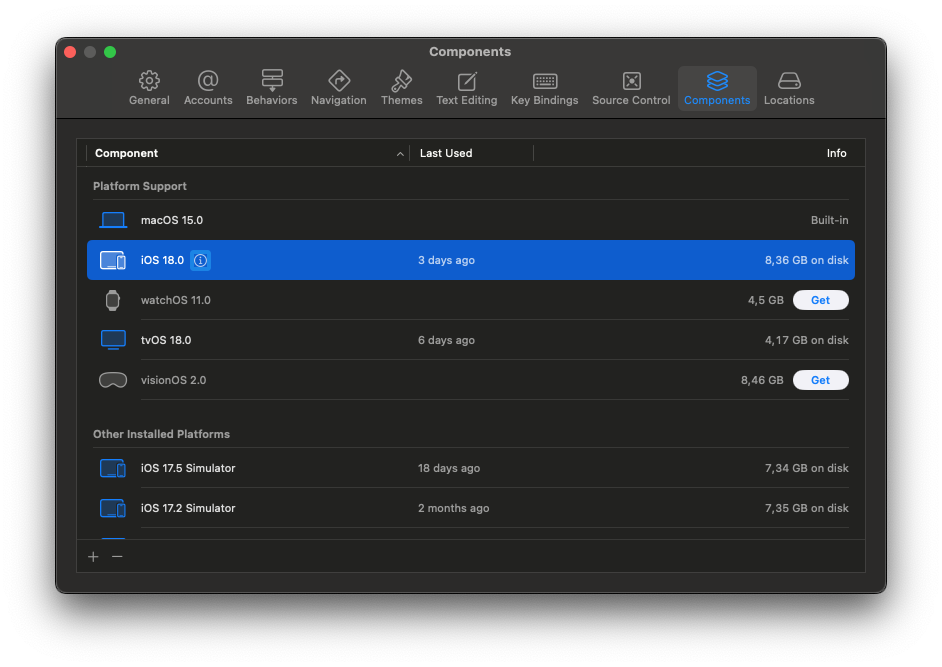-
Notifications
You must be signed in to change notification settings - Fork 519
Known issues in .NET10
This document lists known issues in the SDKs.
It's currently not possible to run a mobile app (iOS, tvOS) on Windows using the command line. Please use an IDE to launch apps from Windows.
Ref: https://github.com/xamarin/xamarin-macios/issues/16609
- Use the following command to get a list of all the simulators:
$ /Applications/Xcode.app/Contents/Developer/usr/bin/simctl list-
Choose one, and copy the corresponding UDID.
-
Set the
_DeviceNameproperty like this to select the simulator:
dotnet build -t:Run -p:_DeviceName=:v2:udid=<UDID>Note that a simulator runtime identifier must be used (either set in the project file, or passed to the command above like this: /p:RuntimeIdentifier=iossimulator-x64).
-
Open Xcode, then the menu
Window -> Devices and Simulators. -
Choose a device on the left, and copy the
Identifierfrom the device info section. -
Set the
_DeviceNameproperty like this to select the device:
dotnet build -t:Run -p:_DeviceName=<IDENTIFIER>Note that a device runtime identifier must be used (either set in the project file, or passed to the command above like this: /p:RuntimeIdentifier=ios-arm64).
Just dotnet run should work just fine.
If something goes wrong (the app crashes, etc.), it's often useful to see stdout and stderr (Console.Out / Console.Error) from the app (this can even be useful as a debugging mechanism in certain cases). In order to see this output, it's necessary to execute the actual macOS executable directly from the terminal. The executable can be found inside the Contents/MacOS directory of the app, which can be found in the output directory.
An example path for a Mac Catalyst app built for x86_64 (relative to the project directory):
$ ./bin/Debug/net6.0-maccatalyst/maccatalyst-x64/MySimpleApp.app/Contents/MacOS/MySimpleApp
[output]If the app is a universal app (built for both x64 and arm64), the path to the app won't contain the runtime identifier:
$ ./bin/Debug/net6.0-maccatalyst/MySimpleApp.app/Contents/MacOS/MySimpleApp
[output]Ref: https://github.com/dotnet/xamarin/issues/26.
When:
- Building remotely from Visual Studio (on Windows).
- Building for the simulator.
- The remote mac is an ARM64 machine.
Visual Studio will build using the iossimulator-arm64 RuntimeIdentifier.
For some projects this may not work correctly (in particular projects that depend on third-party native libraries that don't provide an iossimulator-arm64 version of their library), and for those cases it's possible to make Visual Studio build using iossimulator-x64 instead, by setting the following property in the project file:
<PropertyGroup>
<ForceSimulatorX64ArchitectureInIDE>true</ForceSimulatorX64ArchitectureInIDE>
</PropertyGroup>This is supported starting in Visual Studio 17.7 preview 3.
If the build fails with an error like this:
No simulator runtime version from [<DVTBuildVersion 21C62>, <DVTBuildVersion 21E213>, <DVTBuildVersion 21F79>] available to use with iphonesimulator SDK version <DVTBuildVersion 22A3362>
or:
The operation couldn't be completed. Failed to locate any simulator runtime matching options: { ... }
Then the problem is that the necessary iOS platform support isn't installed on the macOS machine.
The fix is to open Xcode, go to the menu "Xcode (top left) -> Settings -> Components", and make sure the platform component for the latest iOS version is installed (iOS 18 in this case, in Xcode 16.0):

References: